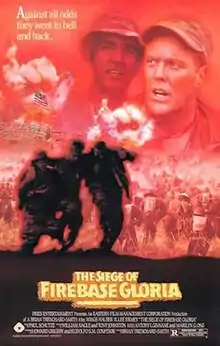The Siege of Firebase Gloria
The Siege of Firebase Gloria is a 1989 war film directed by Brian Trenchard-Smith, starring Wings Hauser and R. Lee Ermey. It was filmed in the Philippines.[1]
| The Siege of Firebase Gloria | |
|---|---|
 US film poster | |
| Directed by | Brian Trenchard-Smith |
| Produced by |
|
| Written by |
|
| Starring |
|
| Music by | Paul Schutze |
| Cinematography | Kevan Lind |
| Edited by | Andrew Prowse |
Production company |
|
| Distributed by |
|
Release date |
|
Running time | 95 minutes |
| Country |
|
| Language |
|
Plot
At the start of the Tet Offensive, a Marine unit on patrol stops at Firebase Gloria. When the base comes under attack the patrol remains to help in its defense. The U.S. Army soldiers and Marines are subjected to numerous attacks by the Viet Cong, but in the end hold the base with assistance from the 1st Cavalry Division. While the Marines try to defend the base, the Viet Cong commander discovers that he is in a similar position: it was never his mission to win the battle, but to lead his men to their deaths in order to allow the North Vietnamese Army to take a more substantial role in the war. The Americans are subsequently forced to abandon the base having lost too many men in the process of defending it. In the end, the soldiers and commanders on both sides take stock of the loss of life for this single base.
Cast
- Wings Hauser as Cpl. Joseph L. Di Nardo
- R. Lee Ermey as Sgt. Maj. Bill Hafner
- Robert Arevalo as Cao Van
- Mark Neely as Pvt. Murphy
- Gary Hershberger as Capt. A.J. Moran
- Clyde Jones as Coates (as Clyde R. Jones)
- Margaret Trenchard-Smith as Capt. Flanagan (as Margi Gerard)
- Richard Kuhlman as Ghost
- John Calvin as C.O. Williams
- Albert Popwell as Sgt. Jones
- Michael Cruz as Vietnamese Child
- Erich A. Hauser as Patrol Member (as Eric Hauser)
- Guel Romero as Patrol Member
- Don Wilson as Patrol Member (as Donald Wilson)
- Nick Nicholson as Photographer
Production
The Siege of Firebase Gloria was filmed on land that was contested by the New People's Army - members of whom had been hired as security guards and extras - and Trenchard-Smith recalled that government-owned helicopters that were to be used in battle scenes arrived half a day late, as their crews had been strafing NPA positions 100 miles north.[2]
Drawing inspiration from his two tours of duty during the Vietnam War, Ermey co-scripted additional scenes for the film in collaboration with the director; Hauser similarly devised his own dialogue for his character's confessional scene near the climax.[2]
According to Trenchard-Smith, he was influenced by Zulu (1964) in his approach to making the film, and that he wanted it to be about "war and reconciliation". To further this theme, the film was to be book-ended by a framing device set years after the Tet Offensive, whereby Ermey's character Sgt. Hafner encounters a Viet Cong soldier he fought against in the titular siege, eventually extending his hand to him and saying "Chào mừng" ("Welcome" in Vietnamese). These scenes were cut prior to the start of sound mixing at the behest of the film's American sales executives, one of whom the director claimed to have said the bookends and other scenes placed "too much emphasis on the gooks". As a compromise, when recording Ermey's in-character narrations, Trenchard-Smith and the actor made additions to what was scripted that emphasised the intended thematic focus.[2]
Release
Although the film was written, produced, and directed by Australians, it was not considered Australian for the AFI Awards due to its primarily American cast.[3]
References
- Scott Murray, Australia on the Small Screen 1970-1995, Oxford Uni Press, 1996 p140
- Trenchard-Smith, Brian. "The Siege of Firebase Gloria". Trailers From Hell. Retrieved 9 August 2020.
- Alex Mitchell, 'AUSSIE MOVIE SHUNNED', Sun Herald, 23 July 1989 p11
External links
- The Siege of Firebase Gloria at IMDb
- The Siege of Firebase Gloria at AllMovie
- The Siege of Firebase Gloria at the TCM Movie Database
- "Brian Trenchard-Smith (Drive Hard) Talks Making a War Movie in a War Zone". The TalkHouse. 18 October 2014.